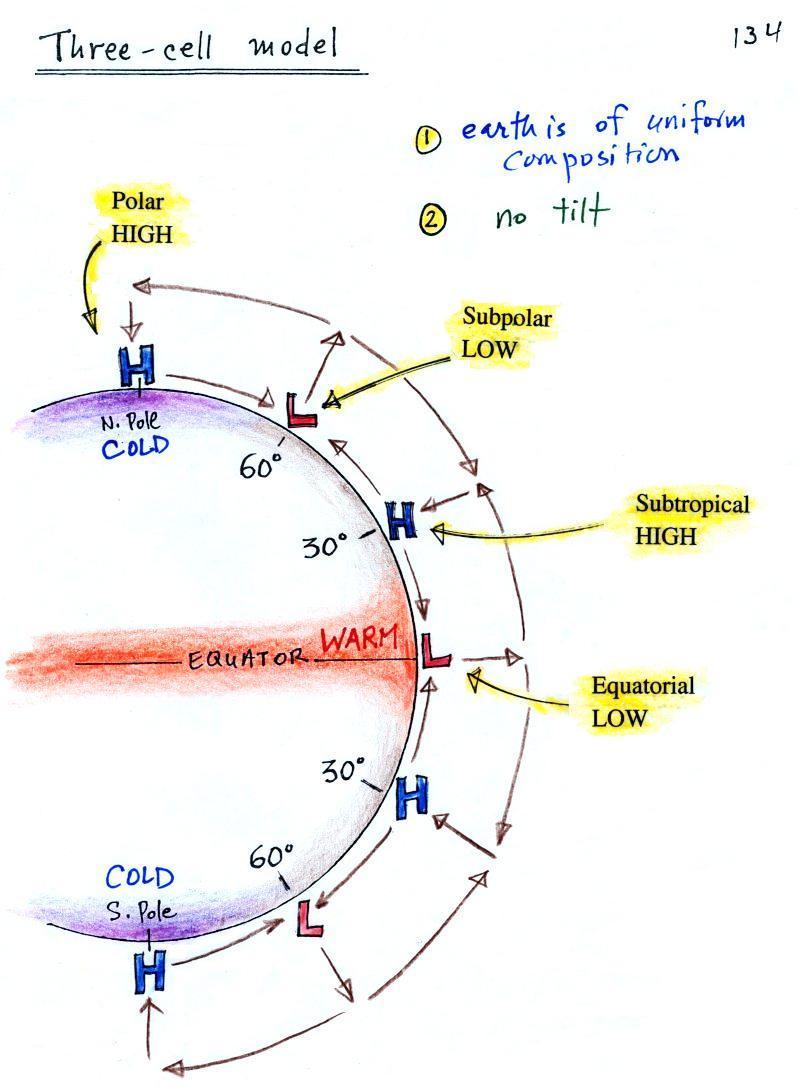
Today we are going to look at the
3-cell model surface
features (pressure
belts
and
winds) in a little more detail. Even with the unrealistic
assumptions of the 3-cell model, much of what is predicted is
actually found on the earth.
Here's a view of the region between 30 S and 30 N latitude from above.
Here's a view of the region between 30 S and 30 N latitude from above.

There's a lot of information on this picture, but with a little study you should be able to start with a blank sheet of paper and reproduce this figure. I would suggest starting at the equator. You need to remember that there is a belt of low pressure found there. Then remember that the pressure belts alternate: there are belts of high pressure at 30 N and 30 S.
Let's start at 30 S. Winds will begin to blow from High pressure at 30 S toward Low pressure at the equator. Once the winds start to blow they will turn to the left because of the Coriolis force. Winds blow from 30 N toward the equator and turn to the right in the northern hemisphere (you need to turn the page upside down and look in the direction the winds are blowing). These are the Trade Winds (northeasterly trade winds north of the equator and southeasterly trades south of the equator). They converge at the equator and the air there rises (refer back to the crossectional view of the 3-cell model). This is the cause of the band of clouds that you can often see at or near the equator on a satellite photograph.
The Intertropical Convergence Zone or ITCZ is another name for the equatorial low pressure belt. This region is also referred to as the doldrums because it is a region where surface winds are often weak. Sailing ships would sometimes get stranded there hundreds of miles from land. Fortunately it is a cloudy and rainy region so the sailors wouldn't run out of drinking water (they might well have run out of rum though which they probably felt was worse).
Hurricanes form over warm ocean water in the subtropics between the equator and 30 latitude. Winds at these latitudes have a strong easterly component and hurricanes, at least early in their development, move from east to west. Middle latitude storms found between 30 and 60 latitude, where the prevailing westerly wind belt is found, move from west to east.
You find sinking air, clear skies, and weak surface winds associated with the subtropical high pressure belt. This is also known as the horse latitudes. Sailing ships could become stranded there also. Horses were apparently either thrown overboard (to conserve drinking water) or eaten if food supplies were running low (after class I had a look at Wikipedia and found a different explanation of the origin of the term "horse latitudes"). Note that sinking air is associated with the subtropical high pressure belt so this is a region on the earth where skies are clear (Tucson is located at 32 N latitude, so we are strongly affected by the subtropical high pressure belt).
The winds to the north of 30 N and to the south of 30 S are called the "prevailing westerlies." They blow from the SW in the northern hemisphere and from the NW in the southern hemisphere. The 30 S to 60 S latitude belt in the southern hemisphere is mostly ocean. Because there is less friction over the oceans, the prevailing westerlies there can get strong, especially in the winter. They are sometimes referred to as the "roaring 40s" or the "ferocious 50s" (the 40s and 50s refer to the latitude belt they are found in).
Here's a sketch of surface features
found from about 15 N to 75 N laitude. We didn't cover this
in class but I'll insert it here anyways.

Winds
blowing north from H
pressure at 30 N toward Low pressure at 60 N turn to the right and blow
from the SW. These are the "prevailing westerlies."
The polar easterlies are cold winds coming down from high pressure at
the north pole. The subpolar low pressure belt is found at 60
latitude. This
is also a convergence zone where the cold polar easterly winds and the
warmer prevailing westerly winds meet. Because the air masses
south and north of 60 latitude are so different, the boundary between
these
two different kinds of air is called the polar front and is often drawn
as a stationary front on weather maps. A strong current of winds
called the polar jet stream is found overhead. Strong middle
latitude storms will often form along the polar front.
Here's a map that shows all of the 3-cell model surface features
Here's a map that shows all of the 3-cell model surface features

This is the same figure included on
the quiz study guide. With a little practice you should be able
to start
with a blank
sheet of paper and reproduce this figure. I would concentrate on
the features found between 45 S and 45 N latitude (i.e. from the
prevailing westerly winds in the southern hemisphere up to the
prevailing westerlies in the northern hemisphere)
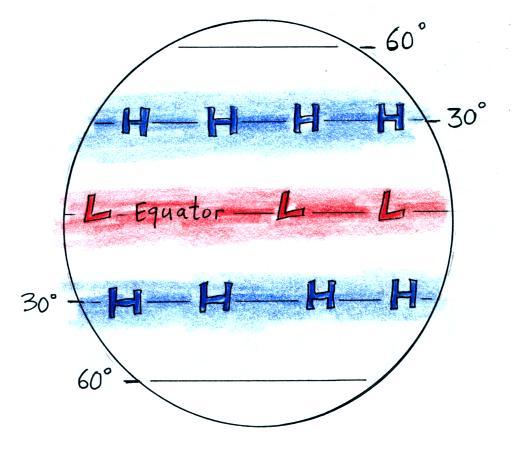 |
 |
The 3-cell model
assumes that the earth is of uniform composition and not tilted toward
or away from the sun. It predicts belts of high pressure at 30 N
and 30 S latitude as shown above at left. Because the
real world
has oceans and continents we find centers of high pressure, not
belts, located
near 30 latitude. They move north and south of 30 degrees during
the year as the N. Pole tilts toward and away from the sun.
The following picture might show this more clearly (this was on a class handout distributed in class)
The following picture might show this more clearly (this was on a class handout distributed in class)
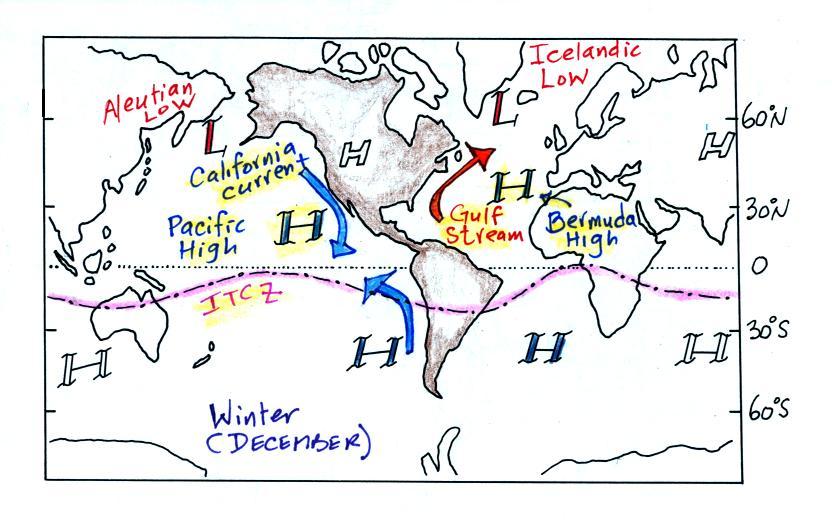
The high pressure center found off
the west coast of the US is called the Pacific High. The Bermuda
High is found off the east coast. Don't worry about the names of
the high pressure centers found in the southern hemisphere.
Winds blowing around these centers of high pressure create some of the world's major ocean currents. The California current is a cold southward flowing current found off the west coast of the US. The Gulf Stream is the warm northward flowing current along the east coast.
The 3-cell model predicts a belt of low pressure near 60 latitude. In the real world we find centers of low pressure: the Aleutian Low off the west coast of Canada and the Icelandic Low off the east coast. These weren't mentioned in class. A true belot of low pressure is found near 60 latitude in the southern hemisphere. This is because that part of the globe is mostly just ocean
The figure above shows the intertropical convergence zone (colored pink) south of the Equator. This happens during the northern hemisphere winter. The ITCZ and the other features move northward in summer. This can be seen by comparing the figure above with the one below.
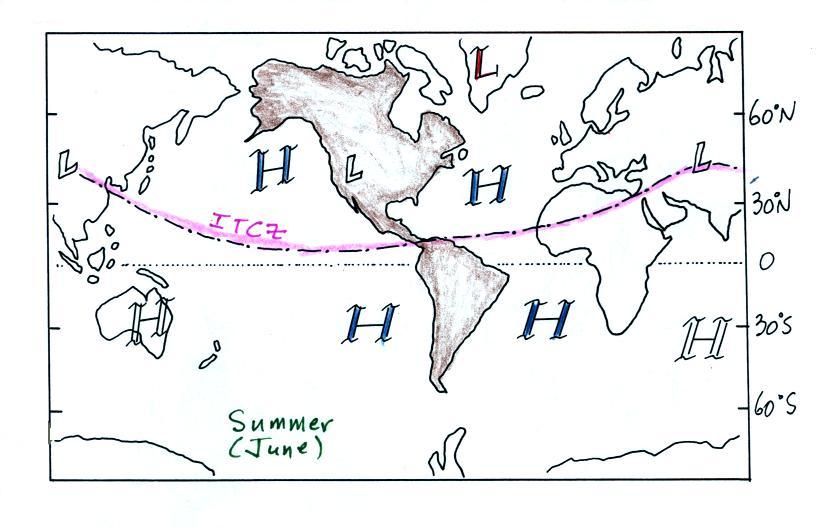
The movement of the Pacific High north and south of its nominal position near 30 degrees latitude is part of what causes our summer monsoon in Arizona.
Winds blowing around these centers of high pressure create some of the world's major ocean currents. The California current is a cold southward flowing current found off the west coast of the US. The Gulf Stream is the warm northward flowing current along the east coast.
The 3-cell model predicts a belt of low pressure near 60 latitude. In the real world we find centers of low pressure: the Aleutian Low off the west coast of Canada and the Icelandic Low off the east coast. These weren't mentioned in class. A true belot of low pressure is found near 60 latitude in the southern hemisphere. This is because that part of the globe is mostly just ocean
The figure above shows the intertropical convergence zone (colored pink) south of the Equator. This happens during the northern hemisphere winter. The ITCZ and the other features move northward in summer. This can be seen by comparing the figure above with the one below.

The movement of the Pacific High north and south of its nominal position near 30 degrees latitude is part of what causes our summer monsoon in Arizona.
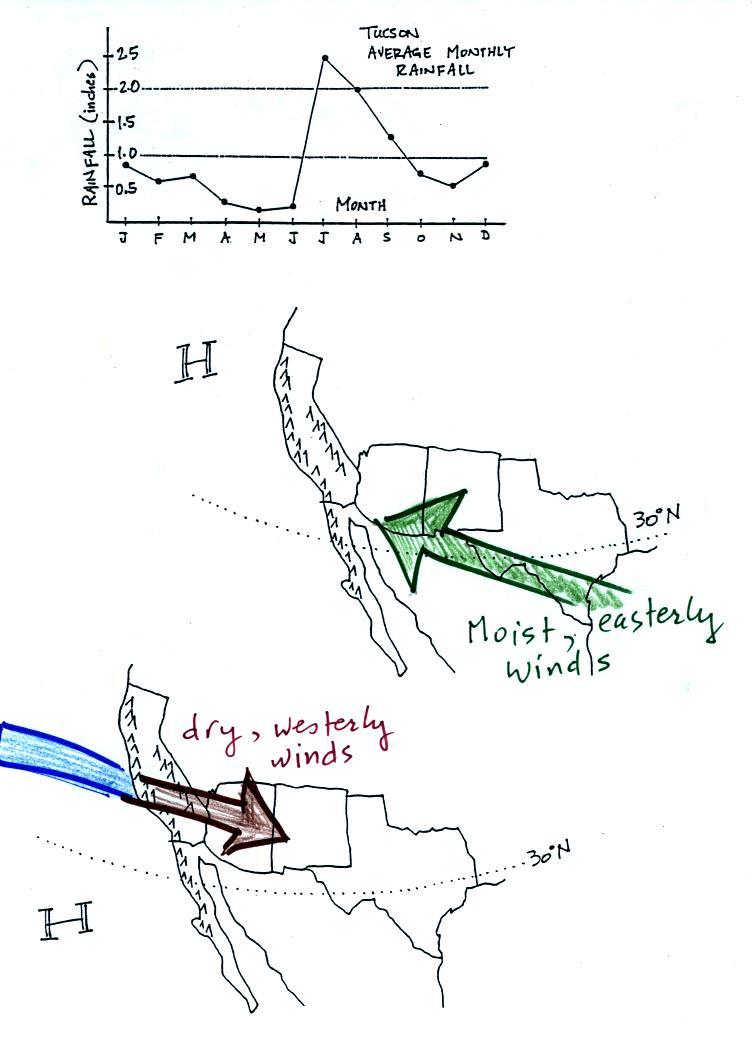
In the
winter the Pacific High is found south of 30 N latitude.
Winds to the north of the high blow from the west. Air
originating over the Pacific Ocean is moist (though the coastal water
is cold so this air isn't as moist as it would be if it came off warmer
water). Before reaching Arizona the air must travel over high
mountains in California. The air loses much of
its moisture as it
does this (remember the rain shadow
effect). The air is pretty dry by the time it reaches
Arizona. Significant winter rains occur in Arizona when storms
systems are able to draw moist subtropical air from the southwest
Pacific ocean into
Arizona.
During the summer, the Pacific High moves north of 30 N latitude. Winds on the southhern side of the subtropical high have an easterly component. Moist air originating in Mexico and from over warm water in the Gulf of Mexico blows into Arizona. The sun heats the ground during the day, warm moist air in contact with the ground rises and produces convective thunderstorms.
Tucson gets about 12 inches of rain in a normal year. About half of this comes during the "summer monsoon" season. Remember the word monsoon refers to a seasonal change in wind direction.
The close proximity of the Pacific high, with its sinking air motions, is what gives California, Oregon, and Washington dry summers.
During the summer, the Pacific High moves north of 30 N latitude. Winds on the southhern side of the subtropical high have an easterly component. Moist air originating in Mexico and from over warm water in the Gulf of Mexico blows into Arizona. The sun heats the ground during the day, warm moist air in contact with the ground rises and produces convective thunderstorms.
Tucson gets about 12 inches of rain in a normal year. About half of this comes during the "summer monsoon" season. Remember the word monsoon refers to a seasonal change in wind direction.
The close proximity of the Pacific high, with its sinking air motions, is what gives California, Oregon, and Washington dry summers.
We're next going to spend a class
or two on
thunderstorms. Here's a little bit of an introduction (found on
p. 150 in the ClassNotes)
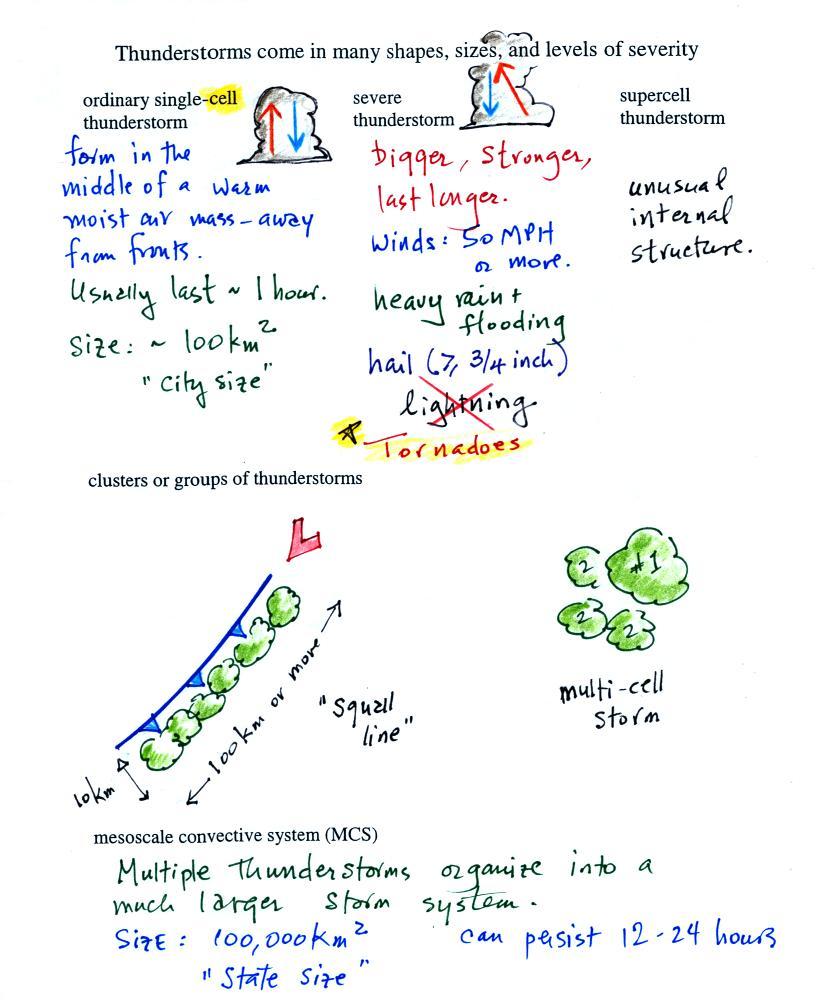
Thunderstorms come in different
sizes and levels of
severity. We will mostly be concerned with ordinary
single-cell thunderstorms
(also referred to as air mass thunderstorms). They form in the
middle of warm moist air, away from front. Most summer
thunderstorms in Tucson are this type. An air mass
thunderstorm has a vertical updraft. A cell is just a
thunderstorm "unit."
Tilted updrafts are found in severe and supercell thunderstorms. As we shall see this allows those storms to get bigger, stronger, and last longer. The tilted updraft will sometimes begin to rotate. We'll see this produces an interesting cloud feature called a wall cloud and tornadoes. Supercell thunderstorms have a complex internal structure; we'll watch a short video at some point that shows a computer simulation of the complex air motions inside a supercell thunderstorm.
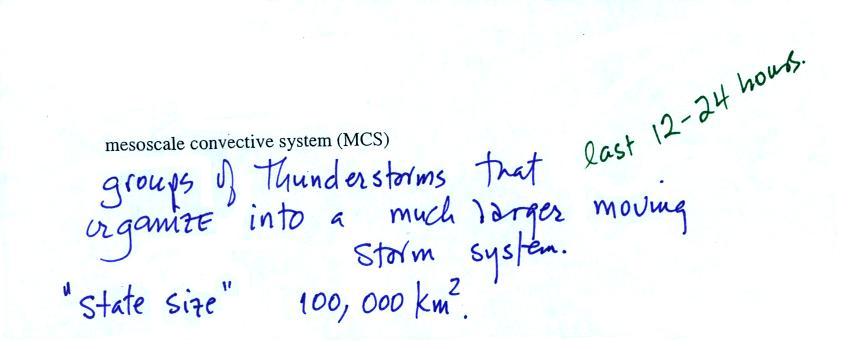
We won't spend anytime discussing mesoscale convective systems except to say that they are a much larger storm system. They can cover a large fraction of a state. They move slowly and often thunderstorm activity can persist for much of a day. Occasionally in the summer in Tucson we'll have activity that lasts throughout the night. This is often caused by an MCS.
Tilted updrafts are found in severe and supercell thunderstorms. As we shall see this allows those storms to get bigger, stronger, and last longer. The tilted updraft will sometimes begin to rotate. We'll see this produces an interesting cloud feature called a wall cloud and tornadoes. Supercell thunderstorms have a complex internal structure; we'll watch a short video at some point that shows a computer simulation of the complex air motions inside a supercell thunderstorm.

We won't spend anytime discussing mesoscale convective systems except to say that they are a much larger storm system. They can cover a large fraction of a state. They move slowly and often thunderstorm activity can persist for much of a day. Occasionally in the summer in Tucson we'll have activity that lasts throughout the night. This is often caused by an MCS.